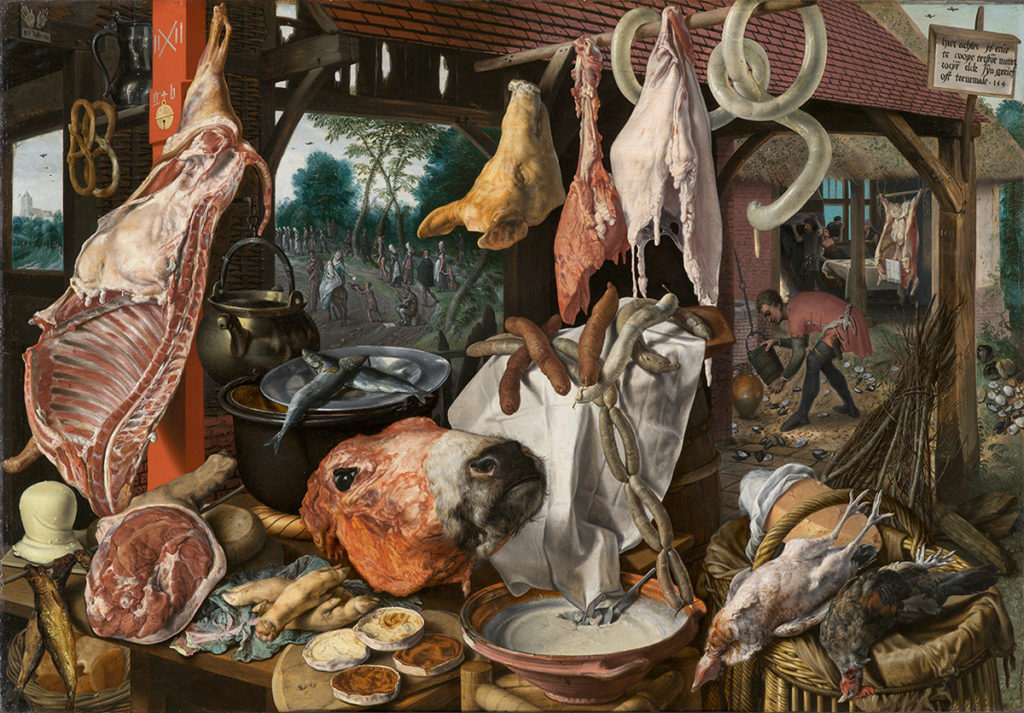A Meat Stall with the Holy Family Giving Alms (work of art)
Artwork Info
Key Ideas
- This still life painting depicts a large display of animal products at an outdoor market.
- Still life paintings are works of art that feature human-made or natural objects that are not alive. These objects include cut flowers, fruit, vegetables, fish, and game (wild animals that are hunted). Still lifes were often created to showcase an artist’s talent, highlight the beauty of everyday life, or illustrate religious stories.
- The scenes in the foreground and background of this painting represent two related ideas. The objects in the meat stall are sources of food (nourishment for the human body). The depiction of the Holy Family giving alms (donations) to people in need represents a symbolic type of food (nourishment for the human soul).
- Pieter Aertsen was a Dutch painter in the 16th century. He is credited with inventing the monumental genre scene, which combines still life and genre painting (often with a biblical scene in the background).
- The NCMA Conservation Department used infrared technology to examine this painting. They found the artist’s sketch under layers of paint. They also saw the changes he made when he painted over his sketch. These findings show that, of the many versions of this subject by Aertsen, this is the original.
Learn More
This still life painting features a large display of meat products. In the background the Holy Family is shown giving donations to people in need. There are two fish (in the shape of a cross) depicted in front of the Holy Family. The fish images point toward the figures in the background. In 16th-century Dutch culture, fish was an important food source during holy seasons. The Church did not allow people to eat meat during holy seasons.
Dutch painter Pieter Aertsen is credited with the invention of the monumental genre scene. This style of painting combines still life and genre painting. It often includes a biblical scene in the background. Aertsen’s work influenced Flemish baroque painting, which was popular in the Southern Netherlands during the 16th and 17th centuries.
This painting reverses the way that subjects are usually featured in a still life. Traditional still life paintings depict a religious or mythological scene as the main subject. Inanimate (nonliving) objects are included as details or decorations. Aertsen depicts the Holy Family in the background instead of featuring them as the main subject. This was a new approach to communicating a message in a work of art. Some art historians interpret this work as a commentary on the ways people consume “food for the body” versus “food for the spirit” (nourishment for the human soul).
This painting shocked many viewers when the artist created it. It was considered a bold move to feature nonliving objects this way in a painting. In spite of this, his painting quickly became famous and many copies of it were made. Copies of paintings generally do not have sketches beneath the layers of paint. They also do not include the artist’s changes. The NCMA Conservation Department used infrared technology to examine this painting. They discovered that the sketch under the layers of paint is different from the final version. Their findings indicate that this is Aertsen’s original painting.
Additional Resources
Resources for Teachers
- Read an article about still life painting and discover why it became popular.
- Read an article about this painting to discover how Aertsen communicated a message in his work.
- View other works by this artist.
Resources for Students
- Watch a video to learn how to create a simple still life drawing.
- View another painting by Aertsen.
- Read a paragraph about the artist.


